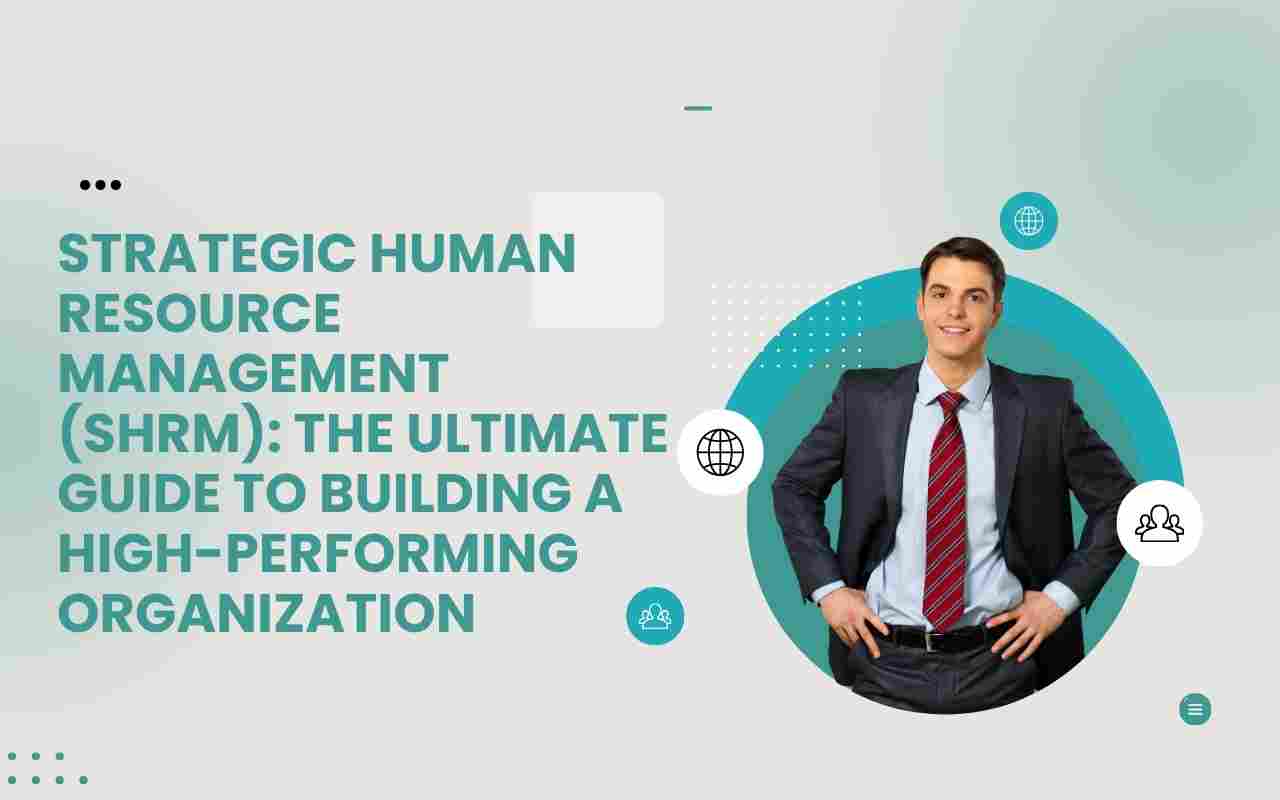Strategic Human Resource Management (SHRM): The Ultimate Guide to Building a High-Performing Organization
Table of Contents
- Introduction to Strategic Human Resource Management
- Evolution of Strategic HRM
- Importance of Strategic HRM in Modern Organizations
- Core Principles of Strategic Human Resource Management
- Strategic HRM vs. Traditional HRM
- Strategic HRM Models
- Key Components of Strategic HRM
- Strategic Planning in HRM
- Role of Strategic HRM in Organizational Performance
- HR Strategy Development Process
- Aligning HR Strategy with Business Goals
- Talent Acquisition and Strategic Staffing
- Performance Management Systems
- Learning and Development as a Strategic Function
- Compensation and Benefits Strategy
- Employee Engagement and Retention
- Workforce Planning and Succession Management
- Diversity, Equity, and Inclusion in Strategic HRM
- Technology and Strategic HRM
- HR Analytics and Data-Driven Decision Making
- Change Management and HR’s Strategic Role
- Strategic HRM in Multinational Corporations
- Legal and Ethical Considerations in SHRM
- Strategic HRM in the Post-Pandemic World
- Challenges and Barriers in Implementing SHRM
- Case Studies in Strategic HRM
- Future Trends in Strategic HRM
- Conclusion
Introduction to Strategic Human Resource Management
Strategic Human Resource Management (SHRM) is the proactive management of people. It requires thinking ahead and planning ways for a company to better meet the needs of its employees while achieving its long-term business goals. In essence, SHRM aligns human capital strategies with business strategies to create a competitive advantage.
Traditional HR focused on administrative tasks such as hiring, payroll, and compliance. SHRM, however, integrates HR functions with strategic organizational objectives, ensuring that every HR initiative contributes to broader business success.
Evolution of Strategic HRM
SHRM evolved from the recognition that human resources could be a source of sustained competitive advantage. In the 1980s and 1990s, HR began transitioning from operational to strategic. Influences such as globalization, technological change, and workforce diversity necessitated a more strategic approach.
From personnel management to human capital management, HR has continuously transformed, embracing data analytics, digital tools, and alignment with business outcomes.
Importance of Strategic HRM in Modern Organizations
Strategic HRM enhances organizational performance by optimizing human capital. It helps businesses navigate complex challenges such as globalization, digital transformation, and talent shortages. Companies that practice SHRM are more agile, resilient, and capable of sustaining growth.
It fosters:
- Employee alignment with corporate goals
- High levels of employee engagement
- Better talent management and succession planning
- Increased productivity and innovation
Core Principles of Strategic Human Resource Management
Key principles include:
- Integration with corporate strategy: HR policies must support overall business direction.
- Long-term orientation: Focus on sustainable talent management.
- Evidence-based decision making: Use data to drive HR strategies.
- Flexibility and adaptability: HR strategies must evolve with external and internal changes.
- Stakeholder alignment: HR must balance employee, customer, and shareholder needs.
Strategic HRM vs. Traditional HRM
| Feature | Traditional HRM | Strategic HRM |
| Focus | Administrative | Strategic alignment |
| Approach | Reactive | Proactive |
| Decision-making | HR department only | Organization-wide |
| Timeframe | Short-term | Long-term |
| Metrics | Compliance & cost | Business impact |
SHRM is not a replacement but an evolution of traditional HRM, expanding its role from transactional to transformational.
Strategic HRM Models
Several models support SHRM implementation:
- Harvard Model: Emphasizes stakeholder interests and situational factors.
- Michigan Model: Focuses on hard HRM, linking HR practices to strategy.
- Guest Model: Highlights HRM outcomes, behavioral outcomes, and performance.
- Best Practice Model: Suggests certain HR practices universally lead to success.
- Best Fit Model: Argues HR strategies should align with business strategy and environment.
Each model provides a different lens to align HR with strategic objectives.
Key Components of Strategic HRM
- Workforce planning
- Talent acquisition
- Training and development
- Performance management
- Compensation and benefits
- Employee relations
- Organizational development
Integrating these components into a strategic framework ensures human capital is effectively utilized.
Strategic Planning in HRM
HR strategic planning involves:
- Environmental scanning
- Defining HR mission and vision
- Setting HR goals and objectives
- Strategy formulation
- Strategy implementation
- Evaluation and feedback
This structured process ensures HR is not operating in a vacuum but contributing to corporate direction.
Role of Strategic HRM in Organizational Performance
Studies show SHRM directly impacts profitability, innovation, and employee satisfaction. High-performing organizations use HR as a lever for change, transformation, and growth.
HR becomes a partner in planning, execution, and evaluation—helping organizations anticipate and adapt to future challenges.
HR Strategy Development Process
A robust HR strategy:
- Analyzes internal and external factors
- Identifies HR priorities
- Aligns talent strategy with business goals
- Involves stakeholders from all functions
- Includes measurable KPIs
The process must be iterative and aligned with broader strategic cycles.
Aligning HR Strategy with Business Goals
Alignment means HR strategies actively support the company’s mission, vision, and objectives. This includes:
- Recruiting talent aligned with strategic needs
- Developing leadership capabilities
- Fostering a performance culture
- Supporting digital and innovation strategies
Talent Acquisition and Strategic Staffing
Strategic staffing ensures the right people are in the right roles. It involves workforce analytics, forecasting, employer branding, and proactive recruitment strategies.
- Building a talent pipeline
- Enhancing candidate experience
- Leveraging AI in recruitment
Performance Management Systems
Performance management should align individual goals with strategic objectives. Modern systems focus on continuous feedback, goal tracking, and employee development.
- Balanced Scorecards
- 360-degree feedback
- Continuous coaching models
Learning and Development as a Strategic Function
L&D ensures employees have the skills needed for strategic success. It includes:
- Learning needs analysis
- Blended learning approaches
- Leadership development
- Succession planning
Compensation and Benefits Strategy
Strategic compensation aligns rewards with performance and business outcomes. It includes:
- Total rewards strategy
- Performance-linked incentives
- Non-monetary rewards
- Equity and fairness
Employee Engagement and Retention
Engaged employees drive innovation and productivity. SHRM creates programs to:
- Enhance job satisfaction
- Build trust and communication
- Provide growth opportunities
Retention strategies include flexible work, recognition, and personalized development plans.
Workforce Planning and Succession Management
Strategic workforce planning anticipates future needs. Succession planning ensures leadership continuity.
- Identify critical roles
- Develop internal talent
- Plan for retirements and turnover
Diversity, Equity, and Inclusion in Strategic HRM
DEI is central to SHRM, promoting innovation, compliance, and reputation.
- Inclusive hiring practices
- Anti-bias training
- Employee resource groups
- Equity audits
Technology and Strategic HRM
Technology transforms HR delivery:
- HRIS and ERP systems
- AI-driven recruitment
- Digital learning platforms
- Virtual collaboration tools
HR Analytics and Data-Driven Decision Making
People analytics support strategic decisions:
- Predictive analytics
- Employee turnover analysis
- Learning ROI measurement
- Engagement tracking
Change Management and HR’s Strategic Role
HR leads organizational change through:
- Change readiness assessments
- Communication strategies
- Training programs
- Stakeholder engagement
Strategic HRM in Multinational Corporations
Global SHRM must address:
- Cross-cultural management
- Local labor laws
- International mobility
- Global talent management systems
Legal and Ethical Considerations in SHRM
Compliance with labor laws, ethical recruitment, and data privacy are critical. SHRM must:
- Ensure fair labor practices
- Prevent discrimination
- Safeguard employee data
Strategic HRM in the Post-Pandemic World
Key shifts include:
- Hybrid work models
- Focus on wellbeing and resilience
- Re-skilling for the digital economy
- Remote performance management
Challenges and Barriers in Implementing SHRM
- Resistance to change
- Budget constraints
- Skill gaps in HR professionals
- Misalignment with business leadership
Overcoming these requires strong HR leadership and cross-functional collaboration.
Case Studies in Strategic HRM
- Google: Talent development and innovation culture
- Unilever: Leadership development and sustainability
- Netflix: Freedom and responsibility culture
Future Trends in Strategic HRM
- AI and automation
- Personalization of employee experience
- Continuous learning culture
- Strategic workforce segmentation
Conclusion
Strategic Human Resource Management is not merely a function—it is a vital strategic partner in organizational success. Companies that invest in aligning HR with business strategy position themselves for sustainable growth, innovation, and resilience in a rapidly changing world.
By embedding SHRM across all levels, organizations unlock their full potential and ensure their workforce is future-ready.







